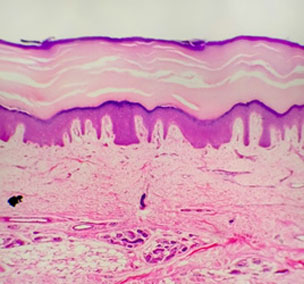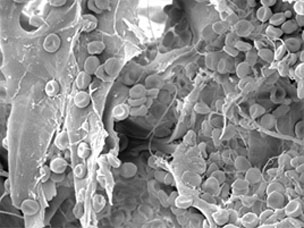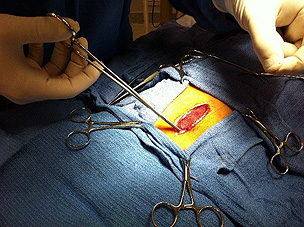Wound healing and tissue regenerationEnsion has developed a collagen-based tissue regeneration matrix that is chemically cross-linked to retain the collagen’s native biological function and mechanical integrity for extended periods in vivo. This enhanced stability provides a provisional matrix for epithelialization and improved wound healing. Ension’s proprietary technology includes the immobilization of glycosaminoglycans and growth factors within the regeneration matrix. These factors amplify the regenerative potential of the matrix by providing the biological signals and cues that are necessary for cellular attachment, growth and differentiation.
Collagen-based hemostatEnsion has effectively harnessed collagen’s natural hemostatic character to create a completely biodegradable and non-toxic hemostatic agent. The collagen is mechanically reinforced to provide the hemostatic agent with architectural elasticity™ allowing injection into an intracavitary wound or piercing injury. After insertion, Ension’s collagen-based hemostat expands to its original shape; retaining its architecture and pushing against the wound bed to establish hemostasis.
Hernia meshPolypropylene is the most commonly used material for hernia meshes. Polypropylene is cost effective, relatively easy to process into fiber formation and chemically and mechanically durable. However, shrinkage of polypropylene meshes is a significant complication caused by periprosthetic adhesions that lead to the encapsulation of the mesh with a rigid fibrotic tissue. These adhesions are caused by tissue trauma, which may be the result of mechanical injury, infection, abrasion, for foreign body reaction in the presence of the synthetic polypropylene mesh. The tissue trauma initiates a cascade of inflammatory events that leads to a decrease in fibrinolytic activity. As a result, the persistence of fibrin provides a provisional matrix that is conductive to invasion of fibroblasts and neovascularization resulting in permanent fibrinous adhesions. Ension, Inc. has developed an engineering bioactive surface for polypropylene hernia meshes to mitigate the foreign body response to prevent the formation of adhesions. Ension's technology guides the foreign body response towards the polypropylene hernia mesh in the progression of inflammation to granulation and finally the formation of a "neoperitoneum" (an intact cellular layer), which integrates the mesh with the host tissue and prevents adhesions.
|
|




